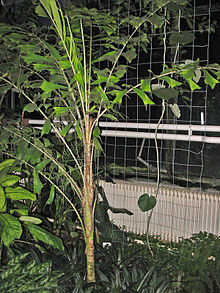- Aiphanes horrida
-
Aiphanes horrida 
Aiphanes horrida in the Jena Botanical Garden Scientific classification Kingdom: Plantae (unranked): Angiosperms (unranked): Monocots (unranked): Commelinids Order: Arecales Family: Arecaceae Subfamily: Arecoideae Tribe: Cocoseae Subtribe: Bactridinae[1] Genus: Aiphanes Species: A. horrida Binomial name Aiphanes horrida
(Jacq.) Burret[2]Synonyms Caryota horrida Jacq.
Aiphanes aculeata Willd.
Euterpe aculeata (Jacq.) Spreng.
Martinezia aculeata (Jacq.) Klotzsch
Martinezia caryotifolia Kunth
Marara caryotifolia (Kunth) H.Karst.
Aiphanes caryotifolia (Kunth) H.Wendl.
Tilmia caryotifolia (Kunth) O.F.Cook
Bactris premorsa Poepp. ex Mart.
Aiphanes premorsa (Poepp. ex Mart.) Burret
Martinezia truncata Brongn. ex Mart.
Aiphanes truncata (Brongn. ex Mart.) H.Wendl.
Martinezia elegans Linden & H.Wendl.
Aiphanes elegans (Linden & H.Wendl.) H.Wendl.
Marara bicuspidata H.Karst.
Martinezia ernestii Burret
Aiphanes ernestii (Burret) Burret
Martinezia killipii Burret
Aiphanes killipii (Burret) Burret
Aiphanes orinocensis BurretAiphanes horrida is a palm native to northern South America and Trinidad and Tobago. Aiphanes horrida is a solitary, spiny tree. In the wild it grows 3–10 metres tall (9–30 feet) tall with a stem diameter of 6–10 centimetres (2–4 inches); cultivated trees may be as much as 15 m (49') tall with a 15 cm (6") diameter.[3] The epicarp and mesocarp of the fruit rich in carotene and are eaten in Colombia, while the seeds are used to make candles.[4] In parts of the Colombian Llanos endocarps are used to play games.[3]
The range of the species is found in dry forests between sea level and 1700 m (5600') above sea level in Bolivia, Brazil, Colombia, Peru, Trinidad and Tobago and Venezuela, but is not native to Ecuador.[4] The species is cultivated as an ornamental throughout the tropics.[3]
Many authors, including Henderson et al. (1995)[4] and Borchenius and Bernal (1996)[3] use A. aculeata rather than A. horrida, giving Jacquin's description of Caryota horrida a publication date of 1809, three years after Willdenow's 1806 description. On the other hand, Govaerts et al. (2006)[5] gives Jacquin's work a publication date of 1801, giving A. horrida priority over A. aculeata.
Contents
Common names
Aiphanes horrida is commonly known by a variety of names including Cocos rura, Mararay, Corozo, Macagüita, Marará[4], Macahuite, Corozo del Orinoco, Corozo anchame, Mararava, Cubarro, Chonta, Chascaraza, Charascal, Corozo chiquito, Corozo colorado, Pujamo, Gualte, Chonta ruro[3], Pupunha xicaxica,[6] Coyure palm, Ruffle palm, Aculeata palm[7] and Spine palm.
See also
References
- ^ Asmussen, Conny B.; John Dransfield; Vinnie Deickmann; Anders S. Barfod; Jean-Christophe Pintaud; William J. Baker (2006). "A new subfamily classification of the palm family (Arecaceae): evidence from plastid DNA phylogeny". Botanical Journal of the Linnean Society 151 (1): 15–38. doi:10.1111/j.1095-8339.2006.00521.x.
- ^ "Aiphanes horrida (Jacq.) Burret, Notizbl. Bot. Gart. Berlin-Dahlem 11: 575 (1932)". Royal Botanic Gardens, Kew: World Checklist of Selected Plant Families. http://www.rbgkew.org.uk/wcsp/namedetail.do?accepted_id=5114&repSynonym_id=34769&name_id=5114&status=true. Retrieved 2007-03-15.
- ^ a b c d e Borchsenius, Finn; Rodrigo Bernal (December 1996). "Aiphanes (Palmae)". Flora Neotropica 70.
- ^ a b c d Henderson, Andrew; Gloria Galeano; Rodrigo Bernal (1995). Field Guide to the Palms of the Americas. Princeton, New Jersey: Princeton University Press. ISBN 0-691-08537-4.
- ^ Govaerts, R.; J. Henderson; S.F. Zona; D.R. Hodel; A. Henderson (2006). "World Checklist of Arecaceae". The Board of Trustees of the Royal Botanic Gardens, Kew. http://www.rbgkew.org.uk/wcsp/home.do. Retrieved 2007-02-06.
- ^ Campos, Marina Thereza; Christiane Ehringhaus (2003). "Plant Virtues Are in the Eyes of the Beholders: A Comparison of Known Palm Uses Among Indigenous and Folk Communities of Southwestern Amazonia". Economic Botany 57 (3): 324–344. doi:10.1663/0013-0001(2003)057[0324:PVAITE]2.0.CO;2. ISSN 0013-0001. http://www.bioone.org/perlserv/?request=get-abstract&doi=10.1663%2F0013-0001%282003%29057%5B0324%3APVAITE%5D2.0.CO%3B2.
- ^ "Aiphanes horrida". PACSOA, the Palm and Cycad Society of Australia. http://www.pacsoa.org.au/palms/Aiphanes/horrida.html. Retrieved 2007-03-16.
External links
- Aiphanes horrida, PACSOA, the Palm and Cycad Society of Australia—includes images of the tree, foliage and fruit.
Categories:- Aiphanes
- Trees of Brazil
- Trees of Trinidad and Tobago
Wikimedia Foundation. 2010.
